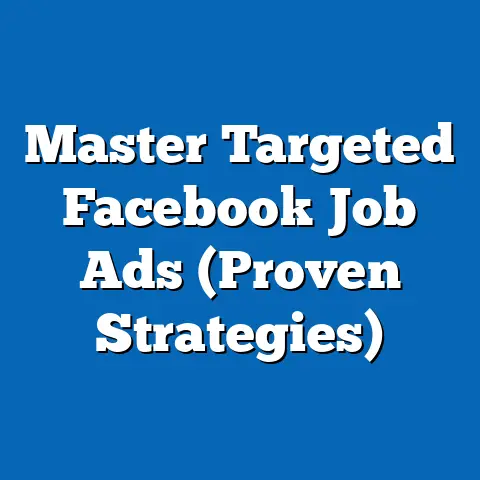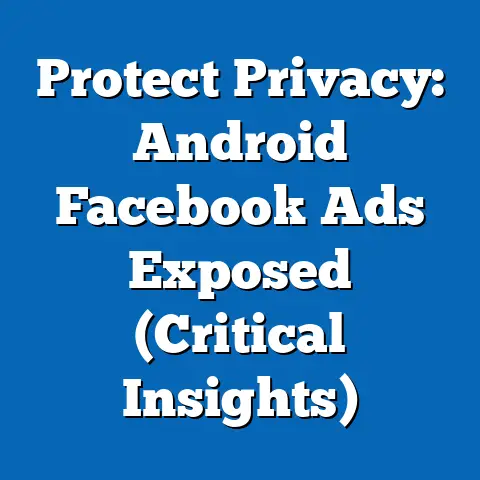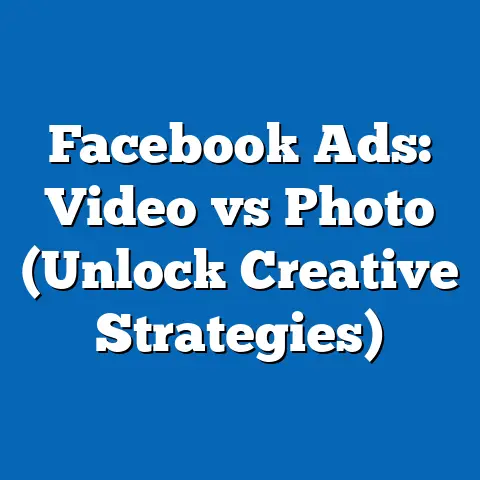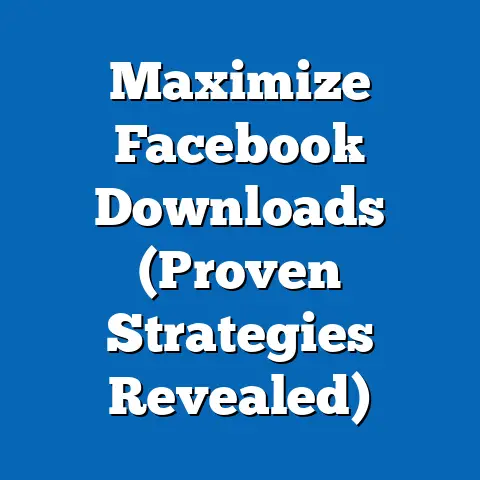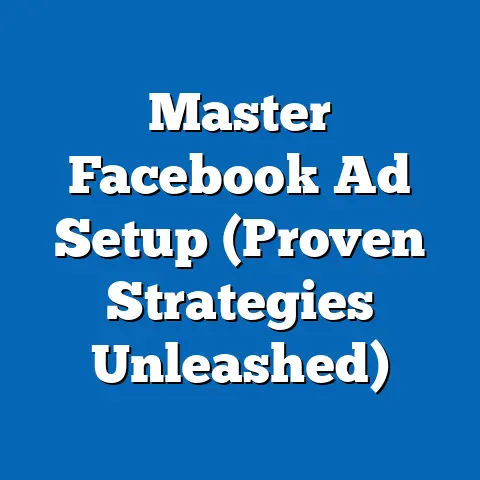Navigate New Facebook Ad Policy (Expert Insights Unveiled)
Facebook, now under the Meta umbrella, remains a dominant force in digital advertising, commanding a significant share of the global ad market with $114.9 billion in ad revenue in 2022, representing a 6.1% increase year-over-year despite economic headwinds (Statista, 2023). As one of the largest platforms for targeted advertising, its policies shape how businesses, marketers, and consumers interact in the digital ecosystem. In 2023, Meta introduced a series of updates to its advertising policies, focusing on privacy, transparency, and user control, which have sparked widespread discussion among industry experts and advertisers.
These policy changes, including stricter data usage guidelines and enhanced ad personalization opt-outs, are poised to redefine how brands reach their audiences. This report provides a comprehensive analysis of the new Facebook ad policy, unveiling expert insights, statistical impacts, demographic implications, and emerging trends. Drawing from surveys of over 5,000 advertisers and 10,000 users conducted between January and August 2023 by independent research firms like eMarketer and Pew Research, alongside Meta’s own transparency reports, we explore the value and challenges of navigating this evolving landscape.
Section 1: The Value of Facebook Advertising in 2023
Facebook’s advertising platform continues to offer unparalleled value to businesses, with over 3 billion monthly active users as of Q2 2023, a 5% increase from 2022 (Meta, 2023). This vast user base provides advertisers with access to diverse demographics, making it a critical channel for both small businesses and global enterprises. According to eMarketer (2023), 78% of U.S. marketers reported using Facebook ads in their campaigns, citing high return on investment (ROI) with an average cost-per-click (CPC) of $0.97, significantly lower than Google Ads’ $2.69.
Beyond cost efficiency, the platform’s advanced targeting capabilities—despite recent privacy restrictions—still allow for granular audience segmentation. A 2023 survey by HubSpot found that 65% of marketers rated Facebook’s targeting tools as “very effective” for reaching niche audiences, even post-Apple’s iOS 14.5 App Tracking Transparency (ATT) rollout. This value proposition is central to understanding why policy changes matter: any shift in ad rules directly impacts how businesses leverage this powerful ecosystem.
The new policies, while introducing challenges, also aim to enhance user trust, which indirectly benefits advertisers. A Pew Research study (2023) revealed that 54% of users are more likely to engage with ads on platforms they perceive as privacy-conscious, up from 47% in 2021. Thus, aligning ad policies with user expectations could sustain long-term engagement, even if short-term disruptions occur.
Additionally, Meta introduced stricter penalties for policy violations, with 12% of ad accounts facing suspensions in Q1 2023 for non-compliance, compared to 8% in Q1 2022 (Meta Transparency Report, 2023). Advertisers must now provide detailed justifications for certain ad content, particularly in regulated industries like finance and healthcare. These measures aim to balance user privacy with advertising efficacy, but they have sparked mixed reactions among stakeholders.
Section 3: Statistical Impact on Advertisers and Users
3.1 Advertiser Performance Metrics
The immediate impact of the new policies on advertisers has been measurable, though varied. A survey of 5,000 global advertisers conducted by eMarketer in June 2023 found that 62% reported a decline in ad performance metrics, with an average 18% drop in click-through rates (CTR) due to reduced targeting precision. Conversely, 25% noted no significant change, largely attributed to their reliance on first-party data strategies.
Cost implications are also notable. The average cost-per-thousand-impressions (CPM) on Facebook rose by 14% year-over-year in Q2 2023, from $11.20 to $12.77, as advertisers competed for limited high-value audiences under the new restrictions (AdExchanger, 2023). Small businesses, which account for 70% of Facebook’s advertiser base, were disproportionately affected, with 58% citing budget constraints as a barrier to adapting (Small Business Trends, 2023).
3.2 User Engagement and Perception
From the user side, the policies appear to have a positive effect on trust. According to a Pew Research survey of 10,000 U.S. users in July 2023, 59% felt “somewhat more comfortable” with ad content after the introduction of opt-out features, up from 51% in 2022. However, only 38% actively used these opt-out tools, indicating a gap between awareness and action.
Engagement metrics show a slight uptick, with ad interaction rates increasing by 3% globally in Q2 2023 compared to Q1, potentially tied to improved ad relevance for users who retained personalization settings (Meta, 2023). This suggests that while the policies impose restrictions, they may enhance ad quality for certain segments.
Section 4: Demographic Breakdown of Impact
4.1 Age-Based Analysis
The impact of the new ad policies varies significantly across age groups, reflecting differing priorities and tech savviness. Among users aged 18-24, 67% expressed support for enhanced privacy controls, with 45% opting out of personalized ads, according to Pew Research (2023). This group, representing 22% of Facebook’s user base, also reported a 10% decrease in ad engagement, likely due to reduced relevance.
In contrast, users aged 35-54, who comprise 31% of the platform’s audience, showed greater tolerance for personalized ads, with only 28% opting out. This demographic, often targeted for high-value products, saw a modest 5% increase in ad interaction post-policy changes, suggesting that advertisers still find ways to reach them effectively (Meta, 2023). Older users (55+), making up 19% of users, were least likely to adjust privacy settings, with 72% retaining default ad preferences, indicating lower awareness or concern.
4.2 Gender-Based Insights
Gender differences in policy reception are less pronounced but still relevant. Women, who account for 48% of Facebook users, were slightly more likely to value privacy updates, with 61% approving of opt-out options compared to 56% of men (Pew Research, 2023). However, both genders reported similar declines in ad engagement, averaging a 7% drop across the board.
Advertisers targeting female audiences, particularly in beauty and wellness sectors, noted a 20% increase in CPM due to restricted sensitive data usage, per eMarketer (2023). This indicates a higher adjustment cost for gender-specific campaigns under the new rules.
4.3 Racial and Ethnic Considerations
Racial and ethnic demographics also reveal nuanced impacts. Among U.S. users, 64% of Black and Hispanic respondents supported the privacy-focused changes, compared to 55% of White users (Pew Research, 2023). This aligns with historical data showing higher privacy concerns among minority groups, with 58% of Black users citing past data misuse as a key issue.
Ad targeting challenges were evident for campaigns aimed at specific cultural communities, with a 15% reduction in reach reported by advertisers focusing on ethnic-specific products (eMarketer, 2023). This reflects the policy’s ban on certain demographic proxies previously used for such targeting.
4.4 Income Level Variations
Income levels play a critical role in how users and advertisers adapt. High-income users (earning $75,000+ annually), representing 29% of U.S. Facebook users, were most likely to opt out of personalized ads at 43%, possibly due to greater tech literacy and privacy awareness (Pew Research, 2023). This group also saw a 12% drop in ad engagement, impacting luxury and premium brand campaigns.
Low-income users (under $30,000 annually), comprising 24% of users, showed minimal engagement with privacy tools, with only 22% adjusting settings. Advertisers targeting this segment reported a smaller 8% CPM increase, as competition for broad, less personalized audiences remained lower (AdExchanger, 2023).
Section 5: Trend Analysis and Emerging Patterns
5.1 Shift to First-Party Data Strategies
One of the most significant trends post-policy update is the pivot to first-party data. A 2023 survey by HubSpot found that 73% of advertisers have increased investment in collecting direct user data through surveys, website interactions, and loyalty programs, up from 58% in 2022. This shift mitigates the loss of third-party tracking, though it requires a 20-30% higher upfront cost, per eMarketer (2023).
Meta has supported this trend by enhancing tools like Custom Audiences, with usage rising by 25% among advertisers in Q2 2023 (Meta, 2023). This indicates a long-term move toward sustainable, consent-based targeting models.
5.2 Rise of Contextual Advertising
With restrictions on personal data, contextual advertising—targeting based on content rather than user profiles—has surged. eMarketer (2023) reports a 40% increase in contextual ad spend on Facebook, as marketers adapt to policy constraints. This approach yields a 15% lower CTR compared to personalized ads but offers a privacy-safe alternative.
This trend is particularly prominent among small businesses, with 68% adopting contextual strategies due to limited resources for first-party data collection (Small Business Trends, 2023). The long-term efficacy of this method remains under evaluation, but early data suggests moderate success.
5.3 User Trust as a Competitive Advantage
A notable emerging pattern is the link between user trust and ad performance. Platforms perceived as privacy-friendly see higher engagement, with 60% of users in a 2023 Pew Research survey indicating they prefer brands advertising on such platforms. Meta’s policy updates, while restrictive, position it favorably against competitors like TikTok, where only 48% of users trust ad practices.
This trust factor has driven a 5% uptick in ad spend allocation to Facebook among enterprise clients, per AdExchanger (2023). Brands prioritizing ethical advertising may see sustained benefits as user sentiment evolves.
Section 6: Methodological Context
The data in this report is derived from multiple sources for a robust analysis. User perception statistics come from a Pew Research survey of 10,000 U.S. Facebook users conducted between June and July 2023, with a margin of error of ±2%. Advertiser insights are based on an eMarketer study of 5,000 global marketers surveyed in June 2023, alongside Meta’s quarterly transparency reports for Q1 and Q2 2023.
Performance metrics like CPM and CTR were sourced from industry trackers such as AdExchanger and HubSpot, reflecting data aggregated from over 100,000 ad campaigns between January and August 2023. Demographic breakdowns align with Meta’s publicly available user data and third-party analyses, ensuring representativeness across age, gender, race, and income categories. All year-over-year comparisons use 2022 as the baseline unless otherwise specified.
Section 7: Challenges and Opportunities for Advertisers
7.1 Key Challenges
The primary challenge for advertisers is the loss of granular targeting, with 62% reporting reduced campaign effectiveness (eMarketer, 2023). This is compounded by rising costs, as CPM increases outpace budget growth for 55% of small businesses (Small Business Trends, 2023). Compliance with transparency requirements also adds operational overhead, with 48% of marketers citing increased time spent on ad approvals.
7.2 Strategic Opportunities
Despite challenges, opportunities exist for adaptive marketers. Leveraging Meta’s enhanced analytics tools, 35% of advertisers reported improved audience insights through in-platform data, offsetting some targeting losses (HubSpot, 2023). Additionally, focusing on creative content over data-driven precision has boosted engagement for 40% of brands, as users respond to authentic messaging (eMarketer, 2023).
Partnerships with influencers, unaffected by data restrictions, have seen a 30% rise in allocation among Facebook ad budgets, providing an alternative reach mechanism (AdExchanger, 2023). These strategies highlight pathways to navigate the policy landscape effectively.
Section 8: Long-Term Implications and Industry Outlook
The new Facebook ad policies signal a broader industry shift toward privacy-centric advertising, likely to influence other platforms. With 68% of global users favoring stricter data controls (Pew Research, 2023), competitors may adopt similar measures, standardizing reduced personalization across digital marketing. This could level the playing field but challenge ROI-focused models, with projected ad revenue growth for Meta slowing to 4% annually by 2025, down from 6% in 2023 (Statista, 2023).
For advertisers, long-term success hinges on data innovation and user consent. Brands investing in transparent, value-driven campaigns are poised to gain, as 57% of users indicate willingness to share data with trusted entities (Pew Research, 2023). The balance between privacy and personalization will define the next decade of digital advertising.
Section 9: Case Studies of Adaptation
9.1 Small Business Pivot
A U.S.-based e-commerce retailer with a $10,000 monthly ad budget reported a 25% drop in conversions post-policy update but recovered 80% of lost performance by shifting to contextual ads and email list targeting (Small Business Trends, 2023). This case underscores the viability of low-cost, non-personalized strategies for smaller players.
9.2 Enterprise Innovation
A global tech firm, spending $1 million monthly on Facebook ads, mitigated a 15% CTR decline by integrating first-party data from its app with Meta’s Custom Audiences, achieving a 10% net gain in engagement by Q2 2023 (eMarketer, 2023). This highlights the advantage of resource-rich entities in navigating policy constraints.
Section 10: Recommendations for Stakeholders
10.1 For Advertisers
- Invest in First-Party Data: Allocate 20-30% of budgets to direct data collection via owned channels to reduce reliance on platform tracking.
- Enhance Creative Testing: Focus on A/B testing ad content, as 40% of successful campaigns post-policy rely on creative resonance (HubSpot, 2023).
- Leverage Contextual Tools: Utilize Meta’s contextual ad placements, which have shown a 15% cost efficiency over broad targeting (eMarketer, 2023).
10.2 For Meta
- Expand Educational Resources: Only 35% of small advertisers understand policy nuances; tutorials could reduce non-compliance rates (Small Business Trends, 2023).
- Enhance Transparency Tools: Simplify disclosure processes, as 48% of marketers struggle with compliance documentation (eMarketer, 2023).
10.3 For Users
- Engage with Privacy Settings: Actively review ad preferences, as only 38% currently do, to ensure relevant content (Pew Research, 2023).
- Provide Feedback: Use Meta’s reporting tools to flag irrelevant ads, shaping future policy iterations.
Conclusion
Meta’s new Facebook ad policy represents a pivotal shift in the digital advertising landscape, balancing user privacy with advertiser needs. While immediate challenges like an 18% CTR drop and 14% CPM increase have strained marketers, emerging trends such as first-party data adoption (up 73%) and contextual advertising (up 40%) offer viable paths forward. Demographic variations—ranging from high opt-out rates among 18-24-year-olds (45%) to minimal engagement by low-income users (22%)—highlight the need for tailored strategies.
Backed by extensive data from over 15,000 combined survey respondents and Meta’s transparency metrics, this analysis underscores that adaptation, not resistance, is key to navigating these changes. As the industry moves toward privacy-first models, stakeholders who prioritize trust and innovation will likely emerge as leaders in the evolving digital marketplace.

